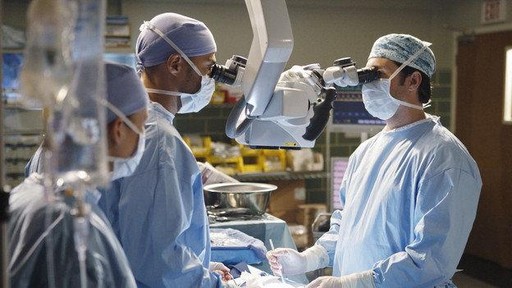
Spinal Cord Tumors - Hemangioblastomas
Oct 29th, 2009
Have you ever tried marking the nose of President Washington on a dollar bill? Through a hole in a cup? With a skinny red pen? Through an insanely high-tech microscope?
Didn't think so. I dare you to try it. It's HARD.
In Episode 607, Dr. Derek Shepherd encounters the "perfect" tumor. Not only has the tumor grown INSIDE the spinal cord, it has reached such complexity that it has basically grown its own circulatory system, feeding on the spine's blood supply. Due to the incredible size (judging by the extensive amount of vertebrae it has reached) and the amazing amount of vascularity, a reasonable solution in this case would be to "cut" the cord where the tumor ends, effectively killing the tumor and its growth. However, the "reasonable" method? Causes the patient to never walk again.
What does it mean when a tumor is "inside the spinal cord"?
First, a little anatomy lesson. The human spine supports the spinal "cord" and the nerves that communicate messages between the brain and the rest of the body. The back has thirty-three bones, 31 pairs of nerves, forty muscles, and several tendons and ligaments. The spinal column has three different divisions of bones: the cervical bones (C), the thoracic bones (T), and the lumbosacral bones (L). The spinal column ENCASES the spinal cord, which is divided into several levels—these different levels control the body's functions. The cervical region of the cord helps functions in the neck, head, shoulders, and arms; the thoracic levels help maintain chest muscles that assist in coughing and breathing; and the lumbosacral region work the legs, pelvis, bowel, and bladder.
All very important stuff.
X-ray Tech Isaac Wade has a hemangioblastoma inside his spinal cord, which is a benign, highly vascular tumor that can be found in the central nervous system—the brain or spine. Depending on the location of the mass, it can cause serious neurologic deficits. Isaac's tumor has already grown to encompass five levels of the spine, all the way up to T2 (the second thoracic vertebrae which helps control the heart and coronary arteries).
How do people know if they have a spinal cord tumor?
Isaac first saw a physician when he began to experience numbness in his legs a few years ago. He suffered a couple of incorrect diagnoses such as poor circulation and a pinched nerve. However, his pain worsened, and he ran an MRI test on his spine. He then found the tumor.
Spinal tumors can present differently in different people, especially due to the location of their growth. Other symptoms include dizziness/vertigo, headaches, nausea/vomiting, and difficulty with balance. However, one of the more consistent signs involves pain. Once people see a medical professional, hopefully they will receive either an MRI or CT scan of the spine in order to find the mass.
Why would an initial treatment plan be to simply "cut the cord"?
Don't think doctors prefer to give up! Most doctors if faced with this situation who felt that their only option would be to cut the cord and refer this patient to a specialist in spinal cord tumors if they felt they were ill-equipped to do other therapy. But even Dr. Derek Shepherd, the specialist among specialists, the best neurosurgeon in the world, initially suggested cutting the cord as an option to Isaac.
Fans, what do you think? Could you let a surgeon operate on you for almost an ENTIRE day? Would you risk the surgery, or would you tell the team to cut the cord?
For more information, please visit:
http://www.cancer.gov/cancertopics/pdq/treatment/adultbrain/patient#Keypoint5 target="_blank"
Didn't think so. I dare you to try it. It's HARD.
In Episode 607, Dr. Derek Shepherd encounters the "perfect" tumor. Not only has the tumor grown INSIDE the spinal cord, it has reached such complexity that it has basically grown its own circulatory system, feeding on the spine's blood supply. Due to the incredible size (judging by the extensive amount of vertebrae it has reached) and the amazing amount of vascularity, a reasonable solution in this case would be to "cut" the cord where the tumor ends, effectively killing the tumor and its growth. However, the "reasonable" method? Causes the patient to never walk again.
What does it mean when a tumor is "inside the spinal cord"?
First, a little anatomy lesson. The human spine supports the spinal "cord" and the nerves that communicate messages between the brain and the rest of the body. The back has thirty-three bones, 31 pairs of nerves, forty muscles, and several tendons and ligaments. The spinal column has three different divisions of bones: the cervical bones (C), the thoracic bones (T), and the lumbosacral bones (L). The spinal column ENCASES the spinal cord, which is divided into several levels—these different levels control the body's functions. The cervical region of the cord helps functions in the neck, head, shoulders, and arms; the thoracic levels help maintain chest muscles that assist in coughing and breathing; and the lumbosacral region work the legs, pelvis, bowel, and bladder.
All very important stuff.
X-ray Tech Isaac Wade has a hemangioblastoma inside his spinal cord, which is a benign, highly vascular tumor that can be found in the central nervous system—the brain or spine. Depending on the location of the mass, it can cause serious neurologic deficits. Isaac's tumor has already grown to encompass five levels of the spine, all the way up to T2 (the second thoracic vertebrae which helps control the heart and coronary arteries).
How do people know if they have a spinal cord tumor?
Isaac first saw a physician when he began to experience numbness in his legs a few years ago. He suffered a couple of incorrect diagnoses such as poor circulation and a pinched nerve. However, his pain worsened, and he ran an MRI test on his spine. He then found the tumor.
Spinal tumors can present differently in different people, especially due to the location of their growth. Other symptoms include dizziness/vertigo, headaches, nausea/vomiting, and difficulty with balance. However, one of the more consistent signs involves pain. Once people see a medical professional, hopefully they will receive either an MRI or CT scan of the spine in order to find the mass.
Why would an initial treatment plan be to simply "cut the cord"?
Don't think doctors prefer to give up! Most doctors if faced with this situation who felt that their only option would be to cut the cord and refer this patient to a specialist in spinal cord tumors if they felt they were ill-equipped to do other therapy. But even Dr. Derek Shepherd, the specialist among specialists, the best neurosurgeon in the world, initially suggested cutting the cord as an option to Isaac.
Fans, what do you think? Could you let a surgeon operate on you for almost an ENTIRE day? Would you risk the surgery, or would you tell the team to cut the cord?
For more information, please visit:
http://www.cancer.gov/cancertopics/pdq/treatment/adultbrain/patient#Keypoint5 target="_blank"



